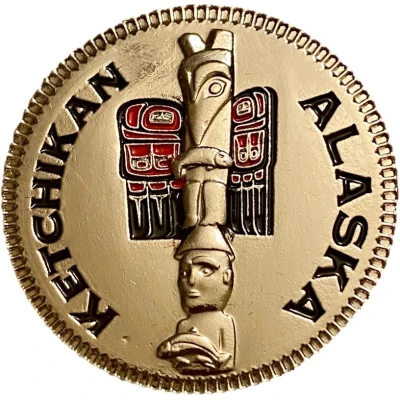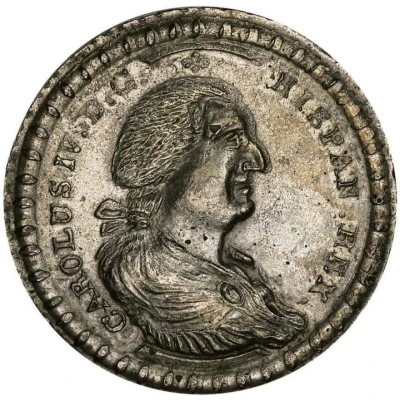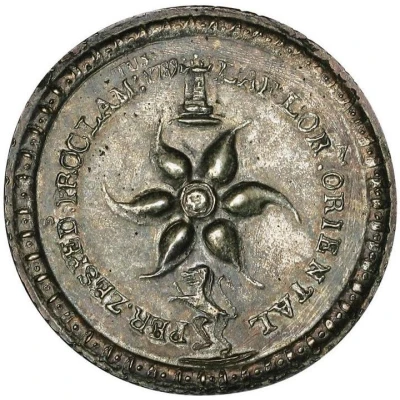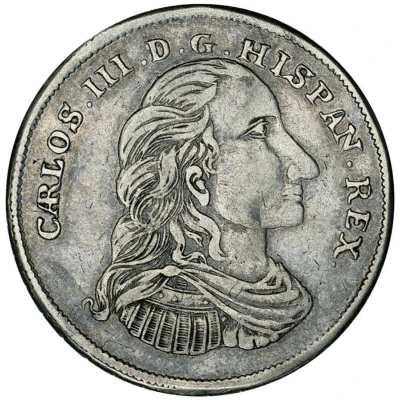
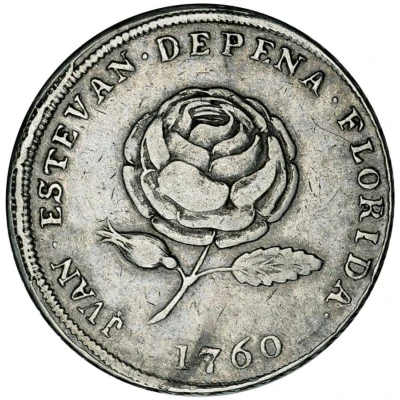

4 Reales - Charles III Ascension of Charles III to the throne
1760 year| Silver | 13.56 g | 31.1 mm |
| Location | Florida (United States (pre-federal and private/territorial)) |
|---|---|
| Type | Medals › Commemorative medals |
| Year | 1760 |
| Value | 4 Reales |
| Currency | Real |
| Composition | Silver |
| Weight | 13.56 g |
| Diameter | 31.1 mm |
| Shape | Round |
| Demonetized | Yes |
| Updated | 2024-11-14 |
| Numista | N#182803 |
|---|---|
| Rarity index | 95% |
Reverse
A short stemmed rose in full bloom, bud (rose hip) on left and leaf on right of stem.
Script: Latin
Lettering: JUAN. ESTEVAN. DE PENA. FLORIDA. 1760.
Edge
Ornamented
Comment
Most probably unique as this is the only struck specimen that has been confirmed to exist by U.S. numismatists.
The reverse type of a rose in full bloom was not chosen at random. During the 1745-47 period, the Mexico City Mint was ordered by King Philip V of Spain to strike a special coinage for Florida. The types for the special Florida coinage were to be a bust of the king on the obverse and a flower on the reverse (in Spanish, Florida means flower). No records survive that the special coinage was actually struck but the memory of the special types must have lingered on in Florida. When Charles III came to the throne as the new King of Spain in 1760, Juan Estevan de Peña had a silver piece struck honoring the new king. De Peña was the royal treasurer of Florida and his house still stands in St. Augustine. For the reverse type he chose the design of a flower, just as intended to be featured on the Florida coinage of 1747.
The specimen in the 1867 Mickley sale (lot 2319) was holed at the top. It served as the source for the line drawing in Herrera (1882). Breen used the Herrera drawing for his Encyclopedia-1078 listing. Herrera's illustration is different from the appearance of the (extremely rare, two or three known) cast examples and may represent a second struck specimen. If so, however, it has not reappeared since the Mickley sale more than 140 years ago! Benjamin Betts published (1898) an illustration of a cast example and noted it looked different from the Herrera piece. The cast Benjamin Betts illustrated has the typical appearance seen on one other and may be taken as representative of how all of them look (for an example ''in the metal'' see the next lot). The casts were not made from a mold taken from a struck specimen or its dies. Rather, the casting mold was specially prepared using the struck piece as its design model.
Joseph Mickley's piece was taken in over the counter at his bullion firm as a silver coin of the value of a U.S. half dollar. When his collection was sold his piece realized $52.50. The present specimen is also the weight of a U.S. half dollar. When it was made in 1760 it was struck to the Spanish coinage weight standard and was worth 4 Reales. Our own country's coinage weight standards were based on Spain's and Spanish silver coins were legal tender in the United States until 1857. Walter Breen calls the Florida 1760 De Peña piece a ''Proclamation 4 Reales'' with good reason, therefore. (Source: https://auctions.stacksbowers.com)
